Characterization and Flame-Retardant Properties of Cobalt-Coordinated Cyclic Phosphonitrile in Thermoplastic Polyurethane Composites
Abstract
1. Introduction
2. Experimental Section
2.1. Synthesis of Flame Retardants
2.2. Preparation of TPU Composite Materials
3. Results and Discussion
3.1. Characterization of CPA
3.2. Characterization of Co@CPA
3.3. Performance Testing of TPU and Its Composite Materials
4. Conclusions
Author Contributions
Funding
Institutional Review Board Statement
Informed Consent Statement
Data Availability Statement
Acknowledgments
Conflicts of Interest
References
- Wan, M.; Shi, C.; Qian, X.; Qin, Y.; Jing, J.; Che, H.; Ren, F.; Li, J.; Yu, B.; Zhou, K. Design of Novel Double-Layer Coated Ammonium Polyphosphate and its Application in Flame Retardant Thermoplastic Polyurethanes. Chem. Eng. J. 2023, 459, 141448. [Google Scholar] [CrossRef]
- Chen, K.; Yang, D.; Shi, Y.; Feng, Y.; Fu, L.; Liu, C.; Chen, M.; Yang, F. Synergistic Function of N-P-Cu Containing Supermolecular Assembly Networks in Intumescent Flame Retardant Thermoplastic Polyurethane. Polym. Adv. Technol. 2021, 32, 4450–4463. [Google Scholar] [CrossRef]
- Khudaida, S.H.; Yen, S.-K.; Su, C.-S. The Application of Box-Behnken Design for Investigating the Supercritical CO2 Foaming Process: A Case Study of Thermoplastic Polyurethane 85a. Molecules 2024, 29, 363. [Google Scholar] [CrossRef] [PubMed]
- Wang, Z.; Jiang, Y.; Yang, X.; Zhao, J.; Fu, W.; Wang, N.; Wang, D. Surface Modification of Ammonium Polyphosphate for Enhancing Flame-Retardant Properties of Thermoplastic Polyurethane. Materials 2022, 15, 1990. [Google Scholar] [CrossRef]
- Desai, S.M.; Sonawane, R.Y.; More, A.P. Thermoplastic Polyurethane for Three-Dimensional Printing Applications: A Review. Polym. Adv. Technol. 2023, 34, 2061–2082. [Google Scholar] [CrossRef]
- Nikam, S.P.; Chen, P.; Nettleton, K.; Hsu, Y.-H.; Becker, M.L. Zwitterion Surface-Functionalized Thermoplastic Polyurethane for Antifouling Catheter Applications. Biomacromolecules 2020, 21, 2714–2725. [Google Scholar] [CrossRef]
- Zheng, R.; Li, M.; Chen, Y.; Hao, F.; Xu, B. Fire Behavior and Mechanical Properties of Phosphorus-Containing Silica Gel Coated Ammonium Polyphosphate as Fire Retardants in Thermoplastic Polyurethane (Tpu). J. Polym. Res. 2023, 30, 392. [Google Scholar] [CrossRef]
- Głowińska, E.; Gotkiewicz, O.; Kosmela, P. Sustainable Strategy for Algae Biomass Waste Management Via Development of Novel Bio-Based Thermoplastic Polyurethane Elastomers Composites. Molecules 2023, 28, 436. [Google Scholar] [CrossRef]
- Tong, Y.; Wu, W.; Zhao, W.; Xing, Y.; Zhang, H.; Wang, C.; Chen, T.B.Y.; Yuen, A.C.Y.; Yu, B.; Cao, X.; et al. Nanohybrid of Co3O4 Nanoparticles and Polyphosphazene-Decorated Ultra-Thin Boron Nitride Nanosheets for Simultaneous Enhancement in Fire Safety and Smoke Suppression of Thermoplastic Polyurethane. Polymers 2022, 14, 4341. [Google Scholar] [CrossRef]
- Lu, S.; Shen, B.; Chen, X. Construction of Charring-Functional Polyheptanazine Towards Improvements in Flame Retardants of Polyurethane. Molecules 2021, 26, 340. [Google Scholar] [CrossRef]
- Wu, J.; Zhang, X.; Qin, Z.; Zhang, W.; Yang, R. Inorganic/Organic Phosphorus-Based Flame Retardants Synergistic Flame Retardant Rigid Polyurethane Foam. Polym. Eng. Sci. 2023, 63, 1041–1049. [Google Scholar] [CrossRef]
- Feuchter, H.; Poutch, F.; Beard, A. The Impact of Halogen Free Phosphorus, Inorganic and Nitrogen Flame Retardants on the Toxicity and Density of Smoke From 10 Common Polymers. Fire Mater. 2023, 47, 1003–1023. [Google Scholar] [CrossRef]
- Silva, N.G.; Zanini, N.C.; de Souza, A.G.; Barbosa, R.F.; Rosa, D.S.; Mulinari, D.R. Halogen-Based Flame Retardants in Polyurethanes. In Materials and Chemistry of Flame-Retardant Polyurethanes Volume 1: A Fundamental Approach; ACS Publications: Washington, DC, USA, 2021; pp. 141–171. [Google Scholar]
- Zemła, M.; Prociak, A.; Michałowski, S. Bio-Based Rigid Polyurethane Foams Modified with Phosphorus Flame Retardants. Polymers 2021, 14, 102. [Google Scholar] [CrossRef] [PubMed]
- Olcay, H.; Gul, C.; Kocak, E.D. Synergism in Nitrogen-and Phosphorus-Based Flame Retardants. In Materials and Chemistry of Flame-Retardant Polyurethanes Volume 2: Green Flame Retardants; ACS Publications: Washington, DC, USA, 2021; pp. 213–247. [Google Scholar]
- Jeevananthan, V.; Shanmugan, S. Halogen-Free Layered Double Hydroxide-Cyclotriphosphazene Carboxylate Flame Retardants: Effects of Cyclotriphosphazene Di, Tetra and Hexacarboxylate Intercalation on Layered Double Hydroxides Against the Combustible Epoxy Resin Coated on Wood Substrates. RSC Adv. 2022, 12, 23322–23336. [Google Scholar] [CrossRef] [PubMed]
- Mayer-Gall, T.; Plohl, D.; Derksen, L.; Lauer, D.; Neldner, P.; Ali, W.; Fuchs, S.; Gutmann, J.S.; Opwis, K. A Green Water-Soluble Cyclophosphazene as a Flame Retardant Finish for Textiles. Molecules 2019, 24, 3100. [Google Scholar] [CrossRef] [PubMed]
- Yu, H.; Tian, L.; Li, T.; Zhu, Y.; Zhu, A.; Guo, X.; Liu, K.; Yang, B.; Guo, J.; Mu, B. Cyclotriphosphazene Hyperbranched P/N/Si Prepared Flame Retardants Improve Mechanical Properties and Flame Retardancy of Epoxy Resins. Polym. Adv. Technol. 2022, 33, 3263–3278. [Google Scholar] [CrossRef]
- Zhu, Y.; Wu, W.; Xu, T.; Xu, H.; Zhong, Y.; Zhang, L.; Ma, Y.; Sui, X.; Wang, B.; Feng, X. Morphology-Controlled Synthesis of Polyphosphazene-Based Micro-and Nano-Materials and their Application as Flame Retardants. Polymers 2022, 14, 2072. [Google Scholar] [CrossRef]
- Ning, K.; Zhou, L.; Zhao, B. A Novel Aminothiazole-Based Cyclotriphosphazene Derivate Towards Epoxy Resins for High Flame Retardancy and Smoke Suppression. Polym. Degrad. Stabil. 2021, 190, 109651. [Google Scholar] [CrossRef]
- Yusuf, A.; Avvaru, V.S.; De la Vega, J.; Zhang, M.; Molleja, J.G.; Wang, D. Unveiling the Structure, Chemistry, and Formation Mechanism of an in-Situ Phosphazene Flame Retardant-Derived Interphase Layer in Lifepo4 Cathode. Chem. Eng. J. 2023, 455, 140678. [Google Scholar] [CrossRef]
- Caдикoв, P.M.; Hypкyлoв, Э.H.; Джaлилoв, A.T. Preparation of Fire-Retardant Polymeric Materials Based on Phosphorus and Metal-Containing Flame Retardants and Study of Physical and Mechanical Properties. Zenodo (CERN Eur. Organ. Nucl. Res.) 2022. [Google Scholar] [CrossRef]
- Yang, B.; Chen, Z.; Yu, Y.; Chen, T.; Chu, Y.; Song, N.; Zhang, Q.; Liu, Z.; Liu, Z.; Jiang, J. Construction of Bimetallic Metal-Organic Frameworks/Graphitic Carbon Nitride Hybrids as Flame Retardant for Unsaturated Polyester Resin. Mater. Today Chem. 2023, 30, 101482. [Google Scholar] [CrossRef]
- Lyu, P.; Hou, Y.; Hu, J.; Liu, Y.; Zhao, L.; Feng, C.; Ma, Y.; Wang, Q.; Zhang, R.; Huang, W.; et al. Composites Filled with Metal Organic Frameworks and their Derivatives: Recent Developments in Flame Retardants. Polymers 2022, 14, 5279. [Google Scholar] [CrossRef]
- Xu, B.; Wu, M.; Liu, Y.; Wei, S. Study on Flame Retardancy Behavior of Epoxy Resin with Phosphaphenanthrene Triazine Compound and Organic Zinc Complexes Based On Phosphonitrile. Molecules 2023, 28, 3069. [Google Scholar] [CrossRef] [PubMed]
- Hou, B.; Zhang, W.; Lu, H.; Song, K.; Geng, Z.; Ye, X.; Pan, Y.-T.; Zhang, W.; Yang, R. Multielement Flame-Retardant System Constructed with Metal Poss-Organic Frameworks for Epoxy Resin. ACS Appl. Mater. Interfaces 2022, 14, 49326–49337. [Google Scholar] [CrossRef] [PubMed]
- Song, K.; Zhang, H.; Pan, Y.-T.; Rehman, Z.U.; He, J.; Wang, D.-Y.; Yang, R. Metal-Organic Framework-Derived Bird’s Nest-Like Capsules for Phosphorous Small Molecules Towards Flame Retardant Polyurea Composites. J. Colloid. Interface Sci. 2023, 643, 489–501. [Google Scholar] [CrossRef]
- Lv, J.; Li, Z.; Dong, R.; Xue, Y.; Wang, Y.; Li, Q. Highly Flame-Retardant Materials of Different Divalent Metal Ions Alginate/Silver Phosphate: Synthesis, Characterizations, and Synergistic Phosphorus-Polymetallic Effects. Int. J. Biol. Macromol. 2023, 247, 125834. [Google Scholar] [CrossRef]
- Chai, H.; Li, W.; Wan, S.; Liu, Z.; Zhang, Y.; Zhang, Y.; Zhang, J.; Kong, Q. Amino Phenyl Copper Phosphate-Bridged Reactive Phosphaphenanthrene to Intensify Fire Safety of Epoxy Resins. Molecules 2023, 28, 623. [Google Scholar] [CrossRef]
- Song, K.; Bi, X.; Yu, C.; Pan, Y.-T.; Xiao, P.; Wang, J.; Song, J.-I.; He, J.; Yang, R. Structure of Metal-Organic Frameworks Eco-Modulated by Acid-Base Balance Toward Biobased Flame Retardant in Polyurea Composites. ACS Appl. Mater. Interfaces 2024. [Google Scholar] [CrossRef] [PubMed]
- Ma, T.; Wang, W.; Wang, R. Thermal Degradation and Carbonization Mechanism of Fe-Based Metal-Organic Frameworks Onto Flame-Retardant Polyethylene Terephthalate. Polymers 2023, 15, 224. [Google Scholar] [CrossRef]
- Wang, R.; Chen, Y.; Liu, Y.; Ma, M.; Hou, Y.; Chen, X.; Ma, Y.; Huang, W. Synthesis of Sugar Gourd-Like Metal Organic Framework-Derived Hollow Nanocages Nickel Molybdate@Cobalt-Nickel Layered Double Hydroxide for Flame Retardant Polyurea. J. Colloid. Interface Sci. 2022, 616, 234–245. [Google Scholar] [CrossRef]
- Huang, R.; Guo, X.; Ma, S.; Xie, J.; Xu, J.; Ma, J. Novel Phosphorus-Nitrogen-Containing Ionic Liquid Modified Metal-Organic Framework as an Effective Flame Retardant for Epoxy Resin. Polymers 2020, 12, 108. [Google Scholar] [CrossRef] [PubMed]
- Chen, X.; Chen, X.; Li, S.; Jiao, C. Copper metal-organic framework toward flame-retardant enhancement of thermoplastic polyurethane elastomer composites based on ammonium polyphosphate. Polym. Adv. Technol. 2021, 32, 2829–2842. [Google Scholar] [CrossRef]


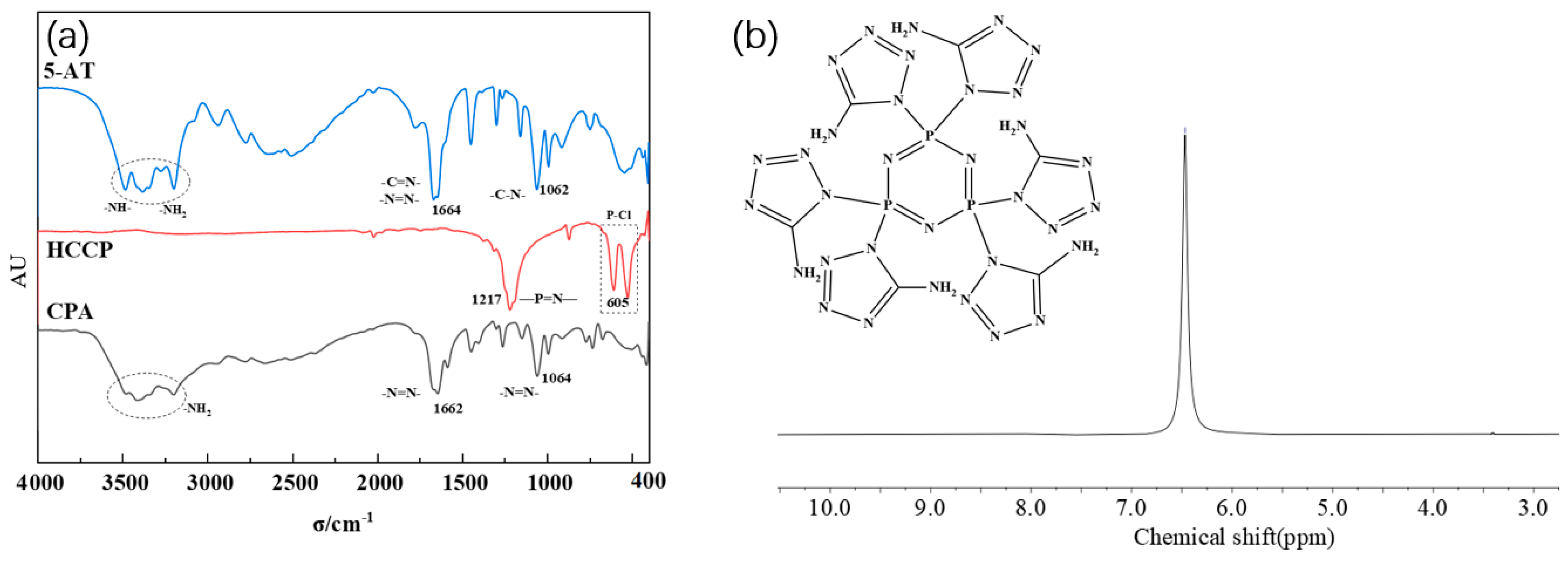
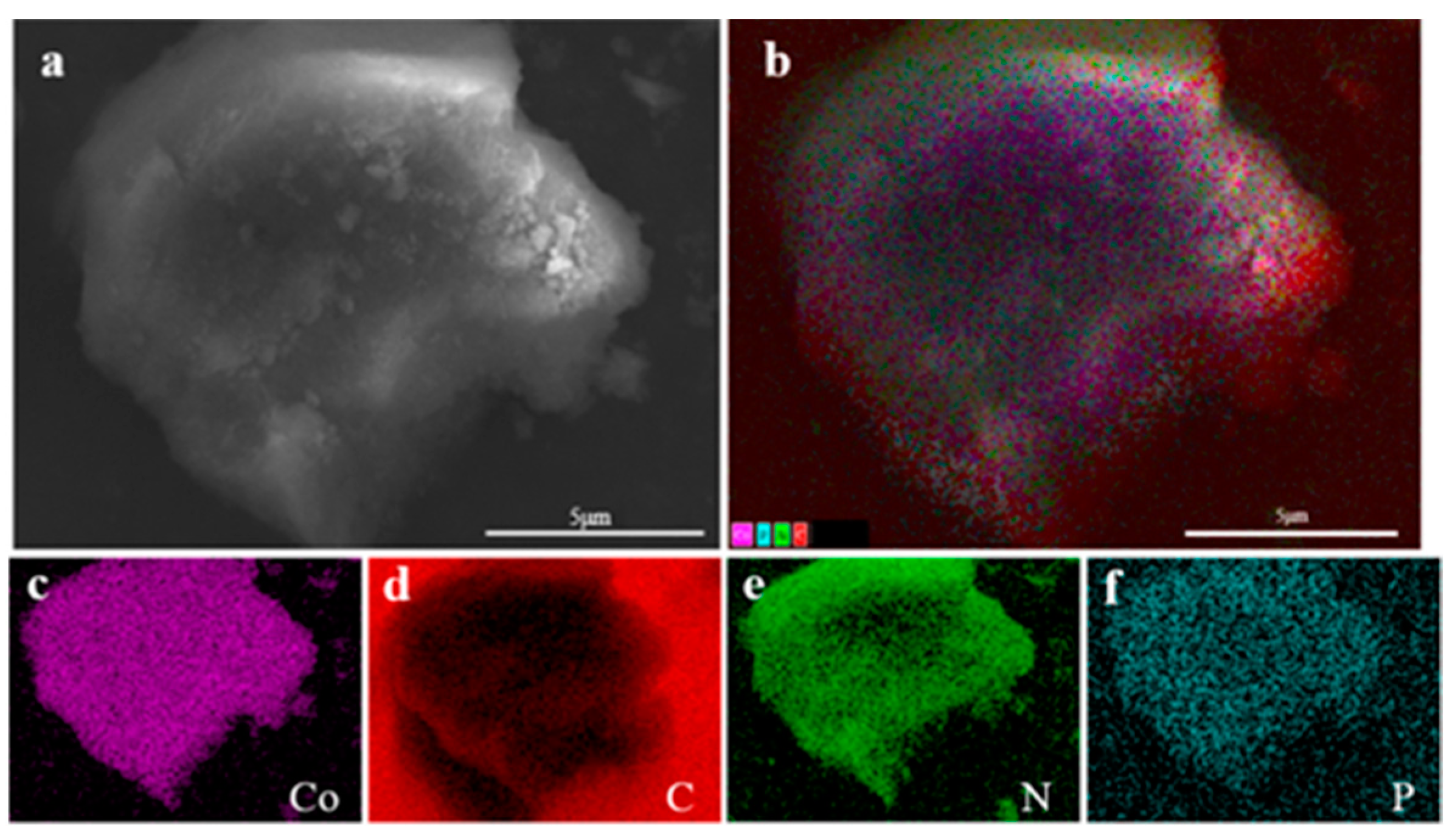
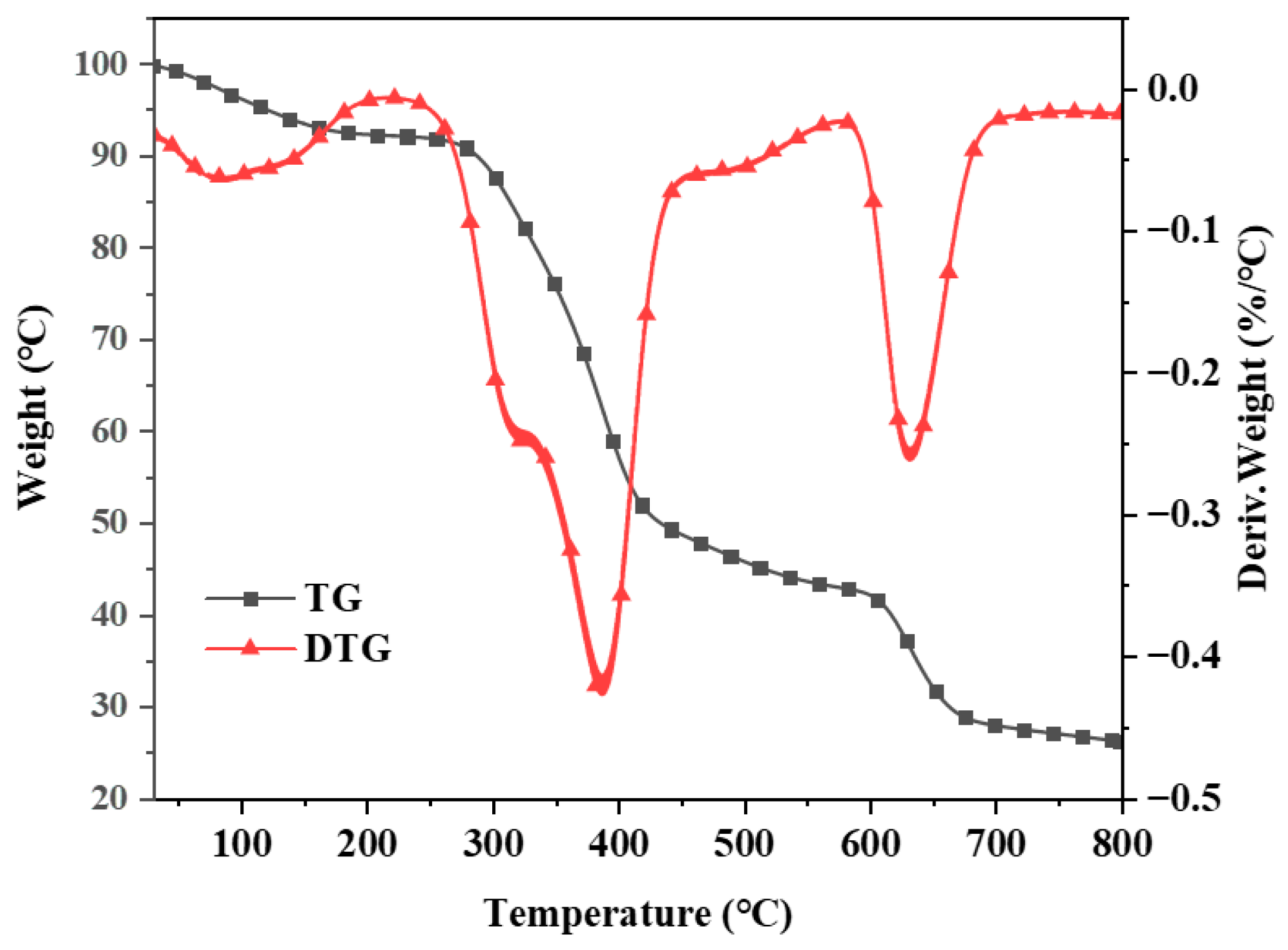


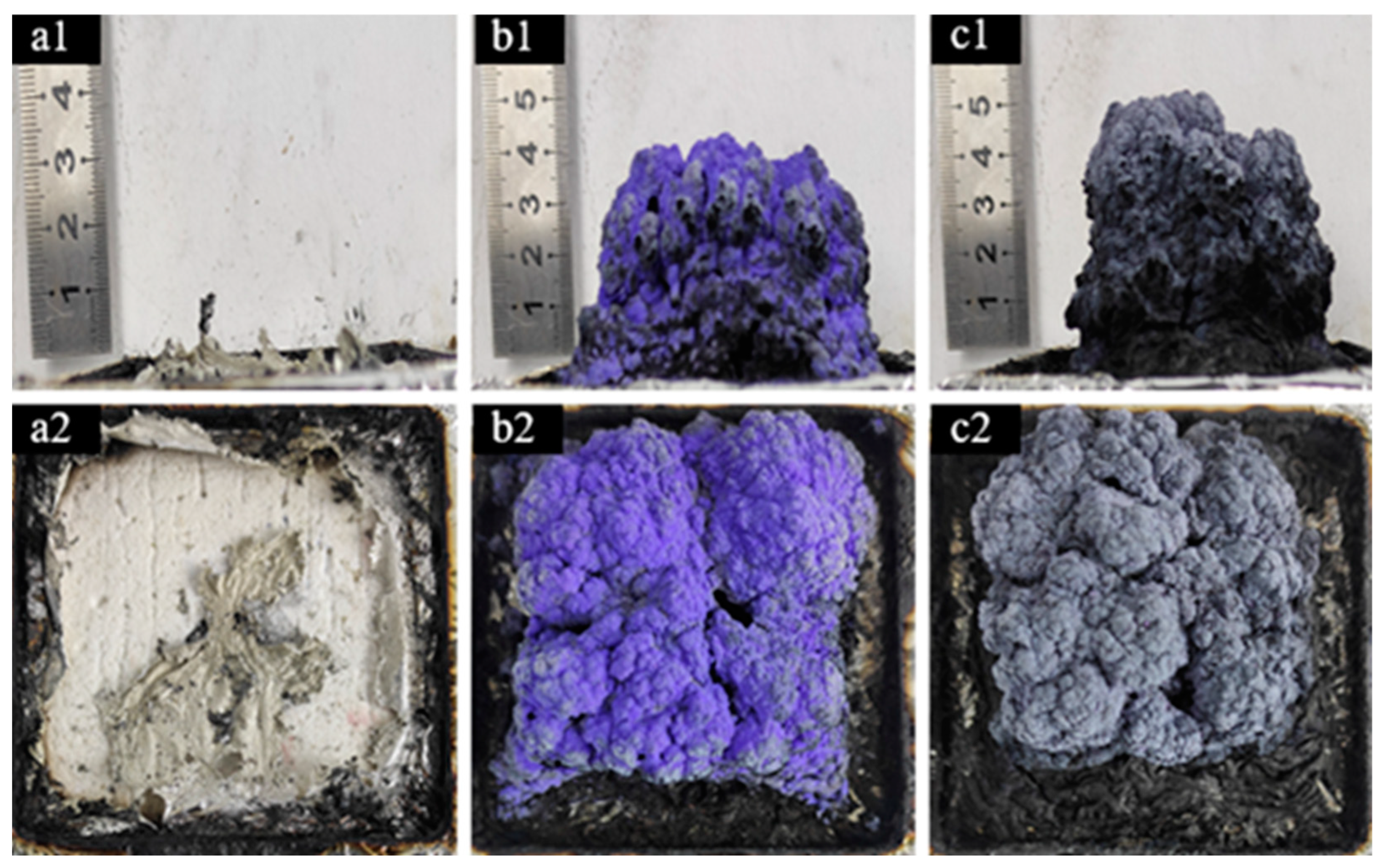
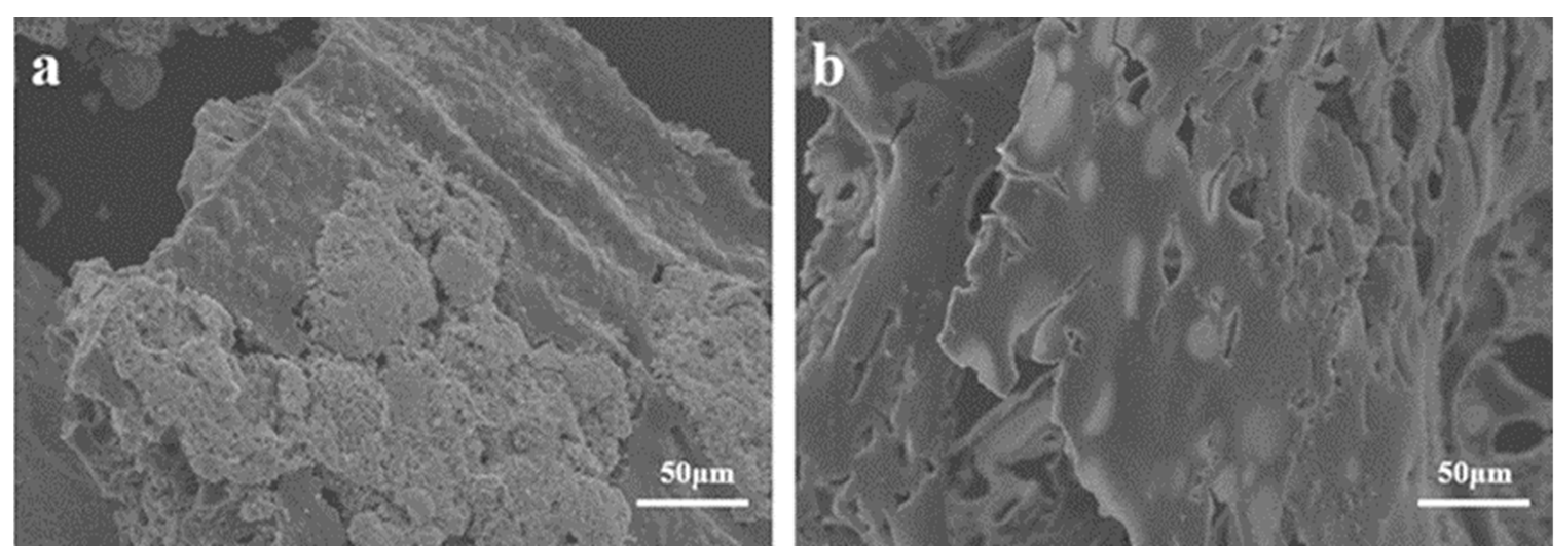
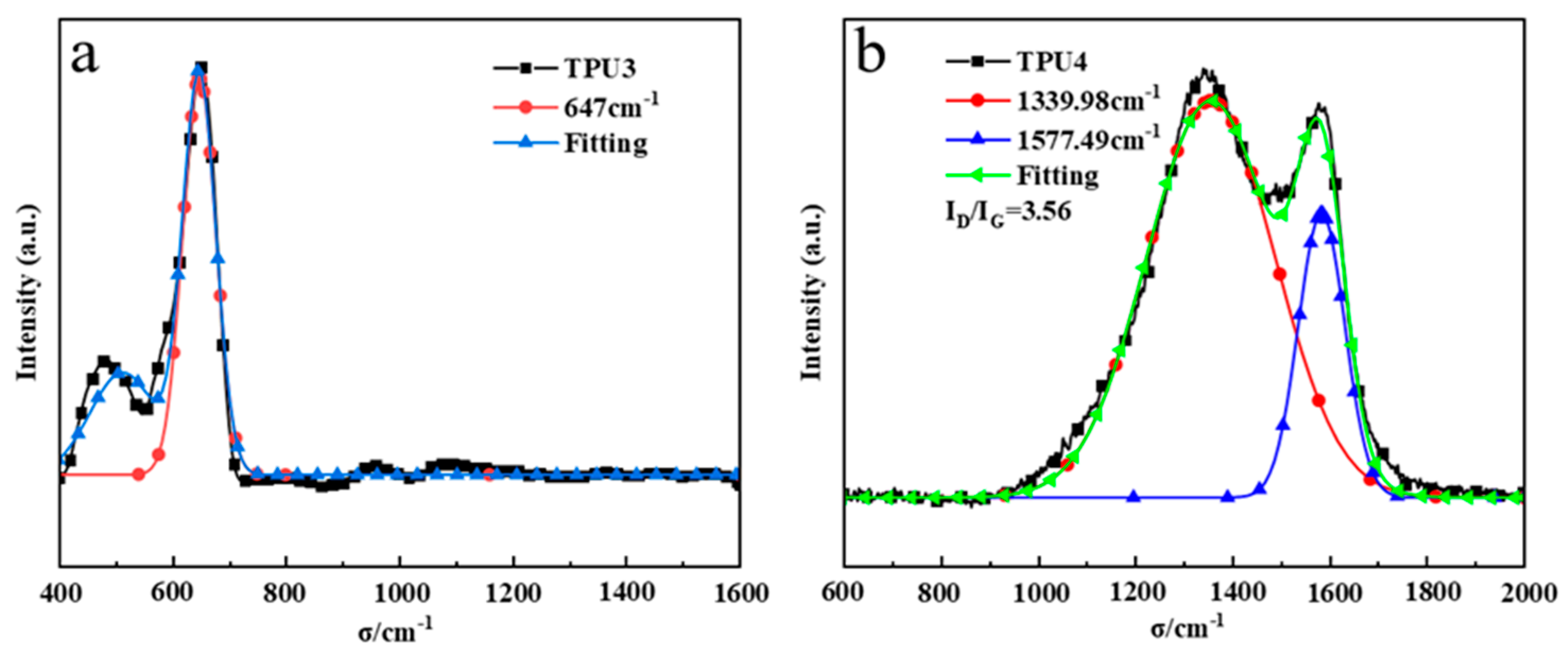
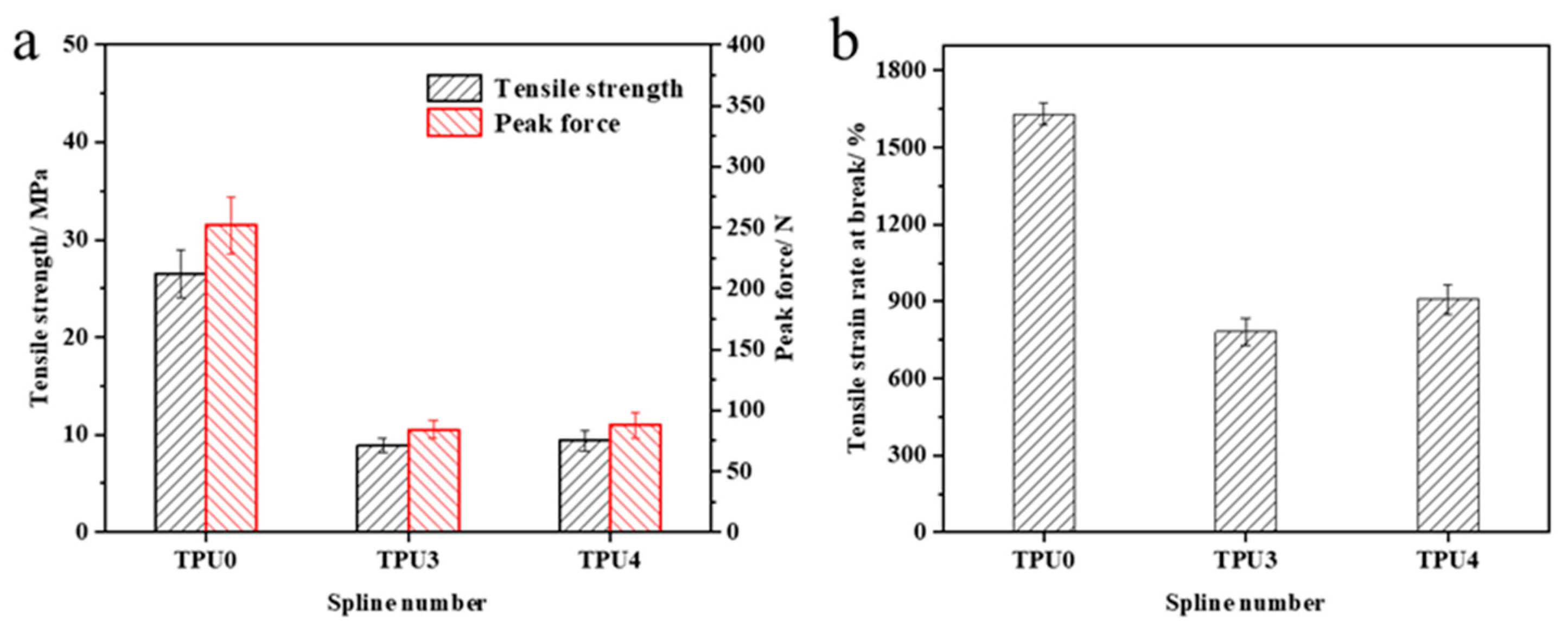
| Num. | w(TPU)/% | w(Co@CPA)/% | w(ODOPB)/% | w(SiO2)/% |
|---|---|---|---|---|
| TPU0 | 100 | N/A | N/A | N/A |
| TPU1 | 88 | 12 | N/A | N/A |
| TPU2 | 75 | N/A | 25 | N/A |
| TPU3 | 75 | 12 | 12 | 1 |
| TPU4 | 75 | 8 | 16 | 1 |
| Num. | Flame-Retardant Performance Testing | ||
|---|---|---|---|
| LOI/% | UL-94 | Molten Drop | |
| TPU0 | 18.0 ± 0.2 | NR | Yes |
| TPU1 | 19.5 ± 0.2 | NR | Yes |
| TPU2 | 20.0 ± 0.1 | NR | Yes |
| TPU3 | 25.0 ± 0.3 | V-0 | No |
| TPU4 | 26.5 ± 0.1 | V-0 | Yes |
| Sample | T−5wt%/°C | Tmax/°C | Residue at 800 °C/wt% |
|---|---|---|---|
| TPU0 | 275.25 | 328.03 | 3.57 |
| TPU1 | 275.25 | 358.18 | 16.86 |
| TPU2 | 288.93 | 407.25 | 9.65 |
| TPU3 | 273.67 | 367.27 | 22.15 |
| TPU4 | 276.89 | 374.00 | 19.68 |
| Num. | TTI/ | THR/ | pk-HRR/ | av-COY/ | av-CO2Y/ | av-EHC/ | MARHE/ |
|---|---|---|---|---|---|---|---|
| s | (MJ/m2) | (kW/m2) | (kg/kg) | (kg/kg) | (MJ/kg) | (kW/m2) | |
| TPU0 | 38 | 99.59 | 1453.6 | 0.33 | 7.55 | 27.43 | 570.32 |
| TPU3 | 20 | 98.91 | 304.95 | 0.23 | 4.96 | 29.44 | 438.62 |
| TPU4 | 20 | 93.05 | 318.38 | 0.20 | 3.86 | 27.31 | 392.82 |
Disclaimer/Publisher’s Note: The statements, opinions and data contained in all publications are solely those of the individual author(s) and contributor(s) and not of MDPI and/or the editor(s). MDPI and/or the editor(s) disclaim responsibility for any injury to people or property resulting from any ideas, methods, instructions or products referred to in the content. |
© 2024 by the authors. Licensee MDPI, Basel, Switzerland. This article is an open access article distributed under the terms and conditions of the Creative Commons Attribution (CC BY) license (https://creativecommons.org/licenses/by/4.0/).
Share and Cite
Zeng, X.; Xu, Z.; Li, H.; Xiong, Y.; Ding, Y.; Xu, L.; Liu, S. Characterization and Flame-Retardant Properties of Cobalt-Coordinated Cyclic Phosphonitrile in Thermoplastic Polyurethane Composites. Molecules 2024, 29, 1869. https://doi.org/10.3390/molecules29081869
Zeng X, Xu Z, Li H, Xiong Y, Ding Y, Xu L, Liu S. Characterization and Flame-Retardant Properties of Cobalt-Coordinated Cyclic Phosphonitrile in Thermoplastic Polyurethane Composites. Molecules. 2024; 29(8):1869. https://doi.org/10.3390/molecules29081869
Chicago/Turabian StyleZeng, Xiangcong, Zhi Xu, Haoxun Li, Yun Xiong, Yigang Ding, Lili Xu, and Shengpeng Liu. 2024. "Characterization and Flame-Retardant Properties of Cobalt-Coordinated Cyclic Phosphonitrile in Thermoplastic Polyurethane Composites" Molecules 29, no. 8: 1869. https://doi.org/10.3390/molecules29081869
APA StyleZeng, X., Xu, Z., Li, H., Xiong, Y., Ding, Y., Xu, L., & Liu, S. (2024). Characterization and Flame-Retardant Properties of Cobalt-Coordinated Cyclic Phosphonitrile in Thermoplastic Polyurethane Composites. Molecules, 29(8), 1869. https://doi.org/10.3390/molecules29081869





